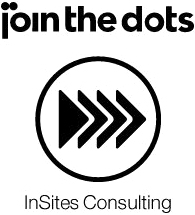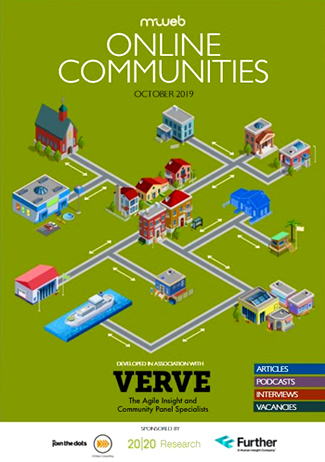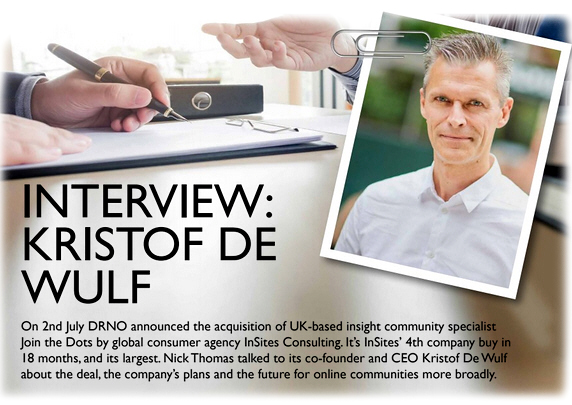Interview: Kristof De Wulf, CEO, InSites Consulting
This is the full version of the interview - an abridged version appears in the October 2019 Communities Supplement July 2018. For the acquisition announcement see DRNO.
NT: Your general reasons for looking for a buy along these lines...
KDW: Our ambition is to become the global leader in online communities - we believe they will become the mainstream method of collaborating with and learning from consumers. We'll see how the industry evolves in the next few years! We're therefore looking for companies that have developed a strong reputation and a strong business in any local market or region that is complementary to our current footprint: so successful in their region, but also focusing in particular on communities as a leading method to conduct MR.
NT: Now focusing on why you chose Join the Dots (JtD) specifically:
KDW: I think lots of reasons are in play. 1. A very strong similar strategic focus on building and running ongoing communities for clients - so the buy will strengthen our community knowhow and business/ client list. 2. Within JtD there are also interesting strategic capabilities we can add to our offering. Their social media intelligence practice is very interesting; and their cultural trends practice, built over the years, is an interesting add-on to our business. 3. A very important one to us - the culture and the DNA of the company - vital for a good integration. We quickly realised that we think in very similar ways and we apply a set of values to our people, to the way we build the business - so there was a lot of commonality there. 4. Related to this, the JtD leadership - we encountered a very experienced and very professional leadership and have embedded that leadership within our company to make sure we can grow a bigger international business. Using their knowhow, including some knowledge that we didn't have - that was very exciting.

NT: And the integration's going well, it seems?
KDW: So far so good; we have worked quite intensively on integration management - at the end of the day we want to build one integrated company. This has been our fourth acquisition so in the meantime we've learned a little bit how to deal with integration management and which processes to put in place. We specifically bought JtD which is a bigger acquisition for us, around 170 people to become part of our group - and spent quite a lot of time on pre-integration management, in discussions with their leadership. We are nearing 500 people, 480 I think. These are quite exciting times for us - every few months there is a whole new company we need to integrate and run - so you need to reinvent yourself a bit.
In the last 18 months, we've had 4 acquisitions and probably doubled the business, and we'll probably do more by the end of this fiscal year... we are going to continue with acquisitions, and there are a few reasons why. This is still a very fragmented market and there are a lot of companies out there, fantastic companies, but they simply don't have the size and scale for example to support tech development - size matters in this industry, so we need to bring a decent size to the table; also to live up to our aims to be the leader in communities. We aim to grow to around EUR 100m in the coming years. We still have a potential deal on the table which we might announce at the end of October or early November, and we'll then probably be somewhere around EUR 70m. It should also help bring in projects - for some reason clients sometimes have more faith in big companies [rightly or wrongly!]. The challenge is to make sure we are integrating all those companies so that for our clients, it feels like one brand, one deliverable, one product view and so on.
One thing we'll do towards this: we aim to make sure the leadership teams of acquired companies invest in our vision - Quen, Graeme and others from JtD are shareholders at group level. There are 18 (private) managing partners in addition to Mentha Capital. We'll see this grow to 25 or 30 in the coming years because this is a model we wish to apply. And at the end of the day, the client needs to benefit from this; what we deliver needs to be more valuable, more scalable. The first thing we should worry about or focus on is the client experience.
NT: Buying firms at this rate, do you have time to integrate them properly?
KDW: Yes, we do, we are freeing up more time. One of our partners has a fulltime dedicated integration management role - he started off 25% focused on it and quickly this became 100%. Bigger companies like JtD also have their own corporate units which can aid us in particular areas of integration; and we have processes, rules of thumb to apply in certain situations with an integration (a body of best practice building up). To be honest, it takes a lot of time to do this properly, and it will never be perfect - each one is a new situation and there will be different challenges we haven't face before.
NT: For the next lot of acquisitions, are there particular areas of research that you're looking to buy in, or particular geographical areas to cover?
KDW: There are two main areas. One is geographical expansion, where we are predominantly looking for agencies that are well known for being great at building and maintaining communities for clients - not a lot of complementarity but a lot of similarity. We are looking at the biggest countries in terms of MR spend, as per ESOMAR stats. We are quite European as you know, we are Belgian, from a small country, so throughout the 22 years we've been running we've always looked to say: What steps can we take, can we internationalise? We did this through greenfield operations a lot of times, but now we have this new non-organic growth that sits next to it.
We are currently also looking to strengthen our tech, in the core. We think communities will be the leading platform, and one reason is that they serve as the aggregator of all kinds of different methods - a good way of 'joining those dots'; but also for clients that have quite a heavy research agenda it makes more sense not to set up each project separately, but to have this whole set-up that has been paid for, where you can reduce the cost and time, and do more through one single vehicle.
From an internal perspective, I also think communities are quite convenient - we are in this self-serve, DIY phase of research development - which will not go away - and what we see today is lots of clients needing to use all kinds of tools to help themselves. We feel the future will move quickly towards aggregators and integrators, where those clients can find all those tools in a one-stop shop.

NT: Would you agree the rise of communities has been slow and steady to date? Is it approaching an inflexion point?
KDW: You're completely right. I think it started out with brands like C Space - one of the pioneers in the US - doing it on a more structural basis, and companies like us were inspired to say 'this is indeed what we should be doing but it's also quite close to the nature of what we've already been building all these years' - and because we are a 100% digital agency, we have no legacy and we were able to embrace that; but there was some resistance from the biggest global MR agencies. For a long time I think they saw it as a trend that would fade out again, and it went quite slowly as a result of that legacy, I think.
The difference now is maybe that we see more DIY these days, more self-service, more tooling in the industry, and at some point, we'll need to bring those skills all together for clients to use them smartly. I think this will be a big push or tailwind for community companies in the years to come, when we see technology moving into consulting and the full-service firms moving more into tech, and I think that's fascinating because we didn't quite see that 12 years ago; there was no talk about tech and DIY and I think that's definitely an accelerator in the adoption of communities. We can still call them communities but they really are melting pots of consumers and methods all in one place.
We actually started on the qual side with online groups, and it was a replication of what we did in the offline world, we simply did it in the digital world. There were already some extra benefits that came up, but at the same time you could say it was still very close to the old practice, e.g. focus groups. We lifted that into ad hoc short-term communities - the next step was to say 'if we can do this for 2 hours, we can also probably do this for 3 weeks, and blend in a more diverse set of tasks, assignments, benefits for consumers'. And then, if we can do it for 3 weeks, why couldn't we do it for 3 months, then for a year because there's just so much more potential we can tap into.
Now we're moving from predominantly qual-driven tasks to a real hybrid environment where we can have quant or qual communities or anything in between.
The next step from that is to build the ultimate Do It Together space (DIT): there's a lot of talk about DIY, and we need to be ready for that and invest heavily to make sure our clients can help themselves on the communities - we think the future is going to be a lot about DIT, where depending on their brands and approach, clients can either DIY or come to us when they need to. Which is challenging because on the one hand the available technology has to be really strong, and on the other we need to make sure that we have the best possible consultants and researchers in the industry. But we're up for a lot of challenges!
NT: You talked about a 'tailwind' getting behind growth, and I admit we've said a few times 'this is going to be the year of online communities', but I still wouldn't say it's booming - do you have a timescale for when it might?
KDW: I don't, I'm not a predictor, partly because it's hard to say it'll be x percent of the MR business by a particular time - but also because of the question of definition - what do we call a community? The word's been used and abused a lot of times, sometimes it's just a bunch of people, maybe a panel, maybe a database, nothing to do with getting people to help shape the future of brands, which is what we are talking about. If you look at Qualtrics, that's obviously going to be a factor [in growth] - they're also predominantly quant-driven but obviously they've put in more features and a lot of DIT thinking on their end, and those big enforcers will trigger a faster move towards this area. I wouldn't call [communities] a method because it's method-agnostic... What's important to us is that within that growing space we are the best we can be.
NT: After all, MR itself is hard to define these days...
KDW: Yes, exactly, and it's getting harder, in terms of how we make sure CMI and other stakeholders do something with the insight, which is completely new territory, not just generating them which is the core of our industry. But once they're there, how do we facilitate stakeholders in their business to start using them, to know about them, to work with them, to generate ideas from them, to step into the consumers' shoes. It's still part of the business, but not something that we thought previously was included in CMI or whatever label you put on it.

NT: Which areas are communities currently taking the most share from?
KDW: A good question. I think a little bit from everywhere, to be honest. Shall we look at traditional first - I would say clients are - very slowly indeed, you're right there - moving away from what we call traditional, focus groups, face-to-face interviews, telephone interviews, into something which we would say is more modern - a more diverse, hybrid way of working together with consumers. That's going slowly - it's hard to break habits... we're all human beings at the end of the day, we work for organisations, and for example we've learned how to do something like run focus groups in a fantastic way, and we still believe they have some unique value, but that value vs communities has been diminishing over the years, obviously. Taking clients in that direction takes time.
Then there is the quant dimension: communities are obviously not going to replace all trackers tomorrow, because you know trackers need fresh samples, that's the one big drawback of any community - that's a limitation.
We see more potential for quant from them... like the work we do for SkyTeam Priority - 10,000 STP members. It's location-based, they get certain triggers, for instance when they arrive at an airport. We used to ask one week after a trip what they liked or disliked about it - so it's very interesting to see in-the-moment options can improve quant measurements.
But even the more novel approaches, like social media monitoring, it can improve. We all know what some of the drawbacks of social media intelligence are - on the one hand, it's scraping data from big populations we don't know a whole lot about, so there's a lot of guesswork, that's one limitation; there's obviously the language dimension, as the dominant language of the Internet is still English; but also what we derive from that is skewed to the profile of the channels - like Twitter, you're listening to Twitter users, you know.
NT: [laughs] Not normal people!
KDW: That's similar to the feedback we received back in the day when we started doing Internet research, we were told like 'those are not normal people', you know, they use the Internet... so a lot of that is still there, and our philosophy of how that can work alongside larger communities (less so for small ones) is: if we can build this social layer on top of all the activities we are doing with consumers, this is massively interesting because not only do we know those people, have we profiled them and have we been working with them for months or years, it also brings in a whole stream of fresh insights, because their day-to-day social media liking etc. is something that can be really interesting. That is something we'll be doing, building a layer of social media intelligence on top of the community - and you could actually say the same of big data, which has sometimes but not always delivered on its promise: we know what's happened, but we don't necessarily know why, we lack a deeper understanding. If we can pull in more behavioural and transactional data from community users, that's an interesting layer of detail we can add on top, but at the end of the day for us it would still be a community. Instead of thinking of [communities] as a method, it's more a hub for information.
There's a huge challenge for us, to preserve the attention and engagement of people, because ultimately, we can have a fantastic platform and all the tools we need, but without the consumers... And there's the privacy as well, the GDPR and the consent, but I think not just consent, consent is the Base Camp 1, it's about engagement which is more, and I think this is one of the biggest challenges for the broader industry. This industry is 70 or 80 years old, right. We know how to do research, but the big secret now is how to engage people in a world with so much to do, so many different channels, so many different brands, attracting attention - especially of the younger generations, Gens Y and Z. It's a hard nut to crack, and there are lots of different things we need to do, there isn't just one. That's high on the agenda, not so much in acquisitions because it's something we need to work out for ourselves/ do ourselves, and we need to be smart about it - it's more of a longer-term goal, but for the entire industry a very important one to crack.
NT: Shorter term, focusing on the present and near future, where's the fertile territory for community providers in terms of the sectors, size of business etc. that are coming on board right now?
KDW: The good news is, for us at least, that we don't see a lot of differences in the speed of different industries or types of clients - they're kind of equally successful across our key sectors. We focus on 3 sectors, FMCG,Services & retail tech, and Media & entertainment. What is sector-related is the way they use it: in CPG contexts, communities are more skewed towards innovation challenges, we set up specific innovation programs to move from the fuzzy front-end all the way to the market, so that's quite typical for the big fast movers; in Service environments the focus lies rather on customer experience, touchpoint optimisation, NPS measurement and so on. That's quite normal, but it's the way they deploy and use the community. Size of business? Well, if you look at a long-term community, there is a certain set-up cost associated with it so for an SME client that doesn't reach a certain threshold - maybe a turnover around EUR 300 to 500 million... also at that sort of size they are likely to have an established MR practice; SMEs that don't have that practice, that's a hard sell, in fact it's not possible... For some smaller companies we still run short-term communities - maybe they just have a need every few years, but the long-term integrated methods to support companies, that's a [hard] sell and I think it's probably not advisable because you can help yourself by setting up a project to deal with a problem at that point in time.
The final trend at the moment: a lot of clients are in experimentation mode, corporate clients like Unilever have been internalising a lot of things over the last 3 years, pushing out agencies. A lot of agencies have suffered from that recently. They are in a DIY space which is going against having communities on the table for them. We sometimes expect the big companies - cross-category - to scale [their communities] big time, but very often that's not the case: I would say we are most successful among the global single-brand companies.
At some point I think this internalising of the processes is not going to last, but it's their hypothesis and we'll see if it holds or not. We believe that, in the end, they will probably not have all the competence in-house, and the agency/client relationship will need to be redefined in DIT terms, whatever that may mean. There will probably be 50 kinds of DIT out there, with all sorts of differences nuances, but what it won't be is a zero-one game, a straight choice between DIY and bringing in an agency.
Kristof De Wulf is co-founder and CEO of InSites Consulting, a global consumer insight & collaboration agency included in the top 10 of GRIT's global list of most innovative agencies. He started his career at Vlerick Business School where he spent more than 15 years taking roles as Associate Marketing Professor, Partner, and Member of the Board. With the recent acquisitions of Direction First, Columinate, eÿeka and Join the Dots, Kristof now inspires more than 450 people around their company purpose to 'empower people to shape the future of brands' in New York, London, Manchester, Sydney, Johannesburg, Singapore, Düsseldorf, Paris, Rotterdam, Ghent and Timisoara. Kristof is 48, lives in Ypres (West-Flanders, Belgium) with his wife and two daughters, is taking his first steps in Krav Maga and loves taking good care of the family's 3 Shetland ponies and 3 chickens.
